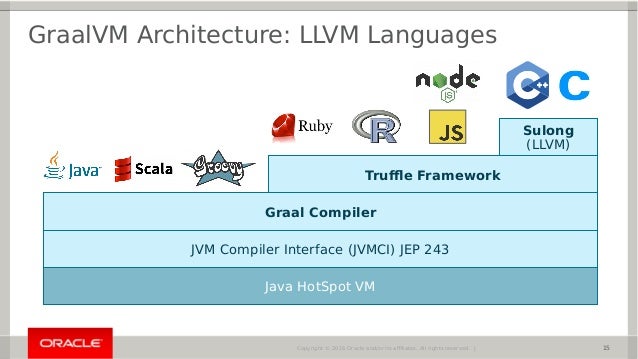What are the (architectural) differences in implementing a programming language on the GraalVM architecture – in particular between Graal, Truffle, and LLVM using Sulong?
I plan to reimplement an existing statically typed programming language on the GraalVM architecture, so that I can use it from Java without much of a hassle.
There are at moment three options:

GraalVM adds an advanced just-in-time (JIT) optimizing compiler, which is written in Java, to the HotSpot Java Virtual Machine.
Emitting JVM bytecode is the traditional option. You will have to work at the bytecode level, and you'll have to optimise your code your before emitting bytecode as the options that the JVM has for optimising it after it has been emitted are limited. To get good performance you may have to use invokedynamic.
Using Truffle is I'd say the easy option. You only have to write an AST interpreter and then code generation is all done for you. It's also the high performance option - in all languages where there is a Truffle version and a bytecode version, the Truffle version confidently outperforms the bytecode version as well as being simpler due to no bytecode generation stage.
Emitting LLVM bitcode and running on Sulong is an option, but it's not one I would recommend unless you have other constraints that lead you towards that option. Again you have to do that bitcode generation yourself, and you'll have to optimise yourself before emitting the bitcode as optimisations are limited after the bitcode is set.
Ruby is good for comparing these options - because there is a version that emits JVM bytecode (JRuby), a version using Truffle (TruffleRuby) and a version that emits LLVM bitcode (Rubinius, but it doesn't then run that bitcode on Sulong). I'd say that TruffleRuby is both faster and simpler in implementation than Rubinius or JRuby. (I work on TruffleRuby.)
I wouldn't worry about the fact that your language is statically typed. Truffle can work with static types, and it can use profiling specialisation to detect more fine-grained types again at runtime than are expressed statically.
If you love us? You can donate to us via Paypal or buy me a coffee so we can maintain and grow! Thank you!
Donate Us With